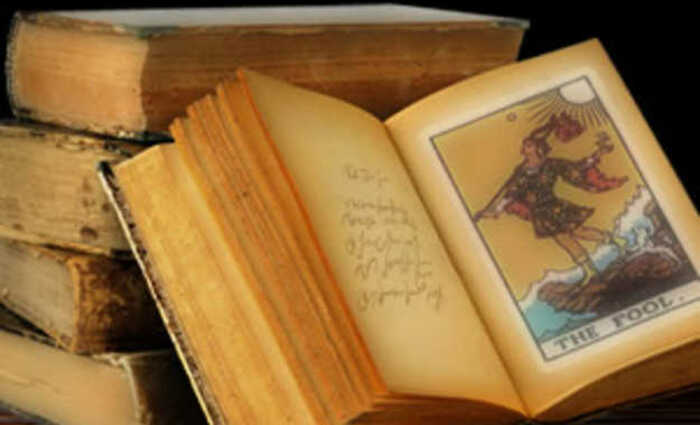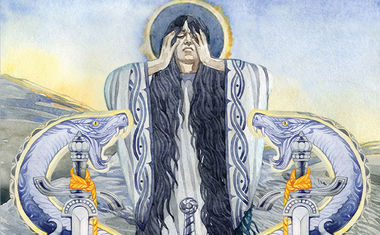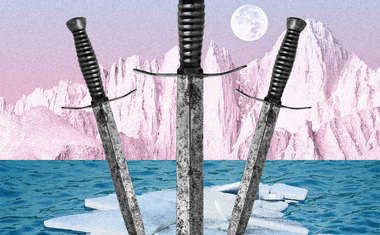
Dante
A detailed look at Dante's Divine Comedy
Part IX: Dante
It occurred to me that as we progressed through this series of studies, it was difficult to see how the many threads were woven together. As the infrastructure of Catharism was violently disrupted, its remnants were transformed by the Spiritual Franciscans with their Joachimism and their institution of the Tertiaries and later the Confraternities. The Gnostic doctrine, inherited from the Bogomils, was supplanted by a Neoplatonic Apocalypticism. Critical pieces in this puzzle are the result of relatively recent scholarship and are not well known in the Tarot community.
It occurred to me that one way to tie the pieces together would be to perform an experiment. If all of these esoteric dynamics were indeed a part of the culture, then we should be able to detect them in that culture, independent of the Tarot. We have an excellent, well-documented, and influential example of the intellectual and spiritual dynamics of the transition period in Dante's Divine Comedy. As one of the best-studied works of European literature, we have a considerable data base of evidence and commentary to draw upon.
So I propose to examine Dante and his epic poem to determine if the spiritual dynamics proposed in earlier chapters were, in fact, an influential element in the Italian culture that the Renaissance inherited. I am not going to test the hypothesis that Dante's masterpiece is the specific source of Tarot imagery. Dante's potential influence will be the subject of a future essay. For the moment, we are concerned with whether or not the Franciscan, Joachimist, Tertiary/Confraternity transformation of the earlier Cathar heresy can be detected in a well-studied example of Pre-Renaissance writing.
To begin with, The Divine Comedy, written between 1308 and 1321 is not Cathar in its doctrine. The sixth circle of the Inferno is the plain of the heretics, and the Cathars are not even mentioned (Bemrose, 2000). Doctrines characteristic of Catharism, such as rejection of the Incarnation, are nowhere to be found in Dante.
There is a clear tie to earlier developments in Provence through the poetry of the troubadors (Bemrose, 2000). Dante was a student of the earlier poets (Barolini, 1993) and the role of Beatrice in the Divine Comedy recalls the concept of "courtly love." There are three dreams in the "Purgatorio" that deal explicitly with the theme of worthy and unworthy lovers (Hollander, 1983). This connection doesn't take us very far, however, since the troubadors had little to do with Catharism (Gere, 1955).
I detect only one possible remnant of Gnosticism in the poem. As I will point out, its origin may not be Gnostic, but to be thorough in our investigation, it needs to be mentioned. This one remnant may be Dante's description of Satan. At the pit of the Inferno, Dante and his guide Virgil find the Devil--embedded and entrapped. Viewed from the perspective of heaven, the Devil is entrapped head-down. That image may be Gnostic in origin (Freccero, 1986).
Bousset (1913) points out that the Gnostic myth of the Anthropos depicts the "first man" as thrown headlong into material existence. The myth is explicitly referred to in the Gnostic "Acts of Peter" (James, 1924) where Peter explains one of the reasons why he requested that he be crucified upside-down: "For the first man, whose image I bear, thrown downward with the head."
So, at a critical turning point in The Divine Comedy, there may be a reference to a traditional Gnostic mythic concept. Dante was an iconoclast (Bemrose, 2000). It is easy to envision him as giggling for weeks over slipping in a heretical Gnostic image! But, at the same time, a single reference in a huge epic drama cannot be given unsceptical affirmation. This is because the image may also have a simple orthodox interpretation.
The orthodox interpretation is in Plato's Timaeus (43e). Plato describes the confusion and the disorder of the newly incarnate soul. The "circles" of reason and passion in the soul are disrupted when it is yoked to a mortal body: " The circles barely held together...their motion was unregulated, now reversed, now side-long, now inverted. It was as when a man stands on his head, resting it on the earth, and holds his feet aloft by thrusting them against something; in such a case right and left both of the man and of the spectators appear reversed to the other party" (Hamilton and Cairns, 1938).
But if there is only a single (questionable) reference to Gnostic heresy in the Divine Comedy, does that mean that the masterpiece is free of heretical implications? The answer is a clear NO! One of the most influential interpreters of Dante, de Salvio (1936), provides convincing arguments that, without his politically powerful patrons, Dante would have been dragged before the Inquisition. We must investigate that claim carefully because it bears on our understanding of how the transformed concepts of Catharism might have been transmitted to 15th century Italy when the Tarot first appears.
Fourteenth century clerical commentators were well aware of Dante's unorthodox tendencies (Hollander, 1993). It is certainly true that Dante deviated from orthodox doctrine, denying, for example, the efficacy of indulgences and prayers for the dead (de Salvio, 1936). Dante is open in his condemnation of corruption in the church (Hawkins, 1993) and of the papacy's attempts to assume temporal power. This was a serious issue in light of a papal letter of 1300: "The Bishop of Rome enjoys absolute supremacy over the Commune of Florence, over Tuscany, over all kings and men on earth. Every man must yield to the highest heirarch of the Church. It is madness to follow a contrary doctrine and to belittle the authority of the Holy See; to attack the full power that God has granted us entails a suspicion of heresy." (de Salvio, 1936, 51). So when Dante places many former popes in the Inferno and notable heretics in Purgatorio, that suspicion of heresy gains verisimilitude.
Nevertheless, the hypothesis of a direct influence from Catharism (de Salvio, 1936) seems overdrawn, even in light of the bending-over-backward openness that we are attempting to maintain in this series of essays. De Salvio points out that Cathar enclaves still existed in Italy during Dante's lifetime. The Northern Italian city-states were still havens of refuge for an active and open expression of Catharism. When Dante was born in Florence, perhaps one third of the noble families were openly sympathetic to the Cathari or had a Perfecti or Perfecta as a family member (de Salvio, 1936). But his arguments for Dante being a relic Cathar are inconsistent with the lack of any characteristic Cathar dogma in The Divine Comedy.
The vision of a transformed Catharism still remains the stronger hypothesis. That transformation was largely effected through the Spiritual Franciscans, so let us begin there. Is there evidence that Dante was aware of and influenced by the Spiritual Franciscans? The answer is a clear YES!
Dante studied philosophy and theology at the Franciscan school at Santa Croce (Bemrose, 2000) which had been strongly influenced by the Spiritual Franciscan (Hawkins, 1993). In the "Paradisio" (xii:121-126), Dante has Bonaventure comment on the controversy between the Spirituals and the Conventuals (Costa, 1981). Canto XI of Paradisio is a glorification of poverty that is virtually a declaration of the Fraticelli position (de Salvio, 1975). Indeed, the Fraticelli cited the Paradisio in defense of their position (Douie, 1932). We know that Dante read heretical works by Ubertino of Casale (McGinn, 1979). The biographies of many of the souls that Dante encounters are taken directly from the chronicles of the Franciscan Salimbene (Coulton, 1907). I have found several websites that claim Dante was a Franciscan Tertiary, but I have been unable to confirm that.
There seems little doubt that Dante was aware of the controversy within the Franciscan order and that his sympathies lay with the Spirituals. But the strongest influence seems to lie with the Spirituals' interpretation of Joachim. Apocalyptic themes and symbols appear throughout Dante's poetry in general (Shapiro, 1983) and The Divine Comedy in particular (Herzman, 1992). Dante's opinion of Joachim becomes clear when he places his soul in Paradise ("Paradisio" xii:140f).
Traces of Joachimist symbols are scattered throughout The Divine Comedy. Davis (1993) points out that veiled references to the anticipated "world ruler" occur in all three major parts of the epic: Inferno, Purgatorio, and Paradisio. Hawkins (1993) points out imagery drawn from the apocalyptic artistic tradition, such as the twenty-four elders and the four winged beasts. Reeves and Hirsch-Reich (1972) argue that the vision of stars formed into a great eagle (sixth level of Paradisio) was probably inspired by one of the figurae in Joachim.
Some of the most direct references to Spiritualist interpretations of Joachim occur at the conclusion of the "Purgatorio" (Kaske, 1983). During the great procession, the eagle of the empire swoops down and leaves its feathers on the chariot of the church--turning it into a monster with a prostitute as its rider (Davis, 1993). Beatrice says that a "five hundred five ten" will come to kill the whore. The solution to her puzzle involves the Roman Numerals DVX and probably derives from Joachim's reference to the "novus dux" (i.e., new leader) who would appear to rebuild Christian Society (Reeves, 1976).
One further aspect of The Divine Comedy needs to discussed: Dante's concept of the spiritual life is very individualistic (Dinsmore, 1901). The whole poem is an individualistic quest--sacraments and church liturgy play no role here (Ryan, 1993). This concept of spirituality as a personal journey is a central tenet of Catharism. However, it is not unique to Catharism and is common to all of the Medieval heresies.
But while this emphasis on personal mysticism shows a sympathy for the heretics, it's immediate inspiration in Dante is far more likely to be orthodox Neoplatonic mysticism. The paradigm involves an individual pilgrim moving through a Neoplatonic cosmograph (Herzman, 1992). Viewed at this mystical level (Luke, 1975), the Neoplatonic underpinnings are most clear in the Paradisio where Dante and his new guide Beatrice ascend through the planetary spheres, the sphere of fixed stars, and the Primum Mobile (Jacoff 1993). At the summit of the cosmos, Dante is granted the Beatific Vision. This personal journey, retracing the steps involved in the creation of the material world, lies at the center of Neoplatonic mysticism and seems a sufficient explanation for the spiritual individualism in Dante.
So what have we learned from examining Dante? At the beginning of the 14th century, enclaves of Catharism still existed in Italy. But their Gnostic dualism had disappeared from the culture, at least insofar as that intellectual culture was exemplified by Dante. Dante acknowledges his indebtedness to the Provencal poets. In an iconoclastic coup, he may possibly have borrowed the image of the "first man" from Gnosticism. But the dualistic doctrine appears nowhere.
On the other hand, the transformed heretical ideas appear prominently in Dante. The opposition to a corrupt Church and the emphasis on individual spirituality, common to all of the Medieval heresies, is clearly evident. Dante praises the apostolic poverty of the Fraticelli and borrows concepts from Spiritual writers. There appears to be consensus among modern scholars that Joachimism played a significant role in Dante's symbolism.
So many of the heterodox spiritual threads that we have documented in other parts of the Italian culture all come together in Dante. In my opinion, this lends credence to the idea that this spiritual dynamic was a part of the intellectual milieu in the early 14th century. This synthesis carried into the 15th century and was at least encouraged by the popularity and influence of Dante's masterpiece.
References
Barolini, T. 1993. "Dante and the Lyric Past." 14-33. R. Jacoff, ed. The Cambridge Companion to Dante. Cambridge University Press, Cambridge.
Bemrose, S. 2000. A New Life of Dante. University of Exeter Press, Exeter.
Bousset, W. 1913. Platons Weltseele und das Kreuz Christi. Zeitschrift fur die Neutestamentliche Wissenschaft 14:275ff.
Costa, D. 1981. Irenic Apocalypse: Some Uses of Apocalyptic in Dante, Petrarch and Rabelais. Anma Libri, 1981.
Coulton, G. G. 1907. From St. Francis to Dante. University of Pennsylvania Press, Philadelphia, PA. rptd. 1972.
Davis, C. T. 1993. "Dante and the Empire." 67-79. R. Jacoff, ed. The Cambridge Companion to Dante. Cambridge University Press, Cambridge.
de Salvio, A. 1936. Dante and Heresy. rptd. 1975. Books for Libraries.
Dinsmore, C. 1901. The Teachings of Dante. rptd. 1970. Books for Libraries.
Douie, D. L. 1932. The Nature and the Effect of the Heresy of the Fraticelli. University of Manchester Press, Manchester.
Freccero, J. 1986. Dante: The Poetics of Conversion. Harvard University Press, Cambridge.
Gere, R. H. 1955. The Troubadors, Heresy, and the Albigensian Crusade. PhD dissertation, Columbia University.
Hamilton, E. and H. Cairns. 1938. The Collected Dialogues of Plato. rptd. 1961. Princeton University Press, Princeton, NJ.
Hawkins, P. S. 1993. "Dante and the Bible." 120-152. R. Jacoff, ed. The Cambridge Companion to Dante. Cambridge University Press, Cambridge.
Herzman, R. B. 1992. "Dante and the Apocalypse." 398-413. Emmerson, R. K. and McGinn, B., eds. The Apocalypse in the Middle Ages. Cornell University Press, Ithaca, NY.
Hollander, R. 1983. "'Purgatorio' XIX: Dante's Siren/Harpy." 77-88. Bernardo, A. S. and A. L. Pellegrini, eds. Dante, Petrarch, Boccaccio. State University of New York at Birmingham Press, 1983.
Hollander, R. 1993. "Dante and His Commentators." 226-236. R. Jacoff, ed. The Cambridge Companion to Dante. Cambridge University Press, Cambridge.
Jacoff, R. 1993. "Shadowy Prefaces: An Introduction to 'Paradisio.'" 208-225. R. Jacoff, ed. The Cambridge Companion to Dante. Cambridge University Press, Cambridge.
James, M. R. 1924. The Apocryphal New Testament. Oxford University Press, Oxford.
Kaske, R. E. 1983. "The Seven Status Ecclesiae in 'Purgatorio' XXXII and XXXIII." 89-113. Bernardo, A. S. and A. L. Pellegrini, eds. Dante, Petrarch, Boccaccio. State University of New York at Birmingham Press.
Luke, H. M. 1975. Dark Wood to White Rose: A Study of Meanings in Dante's Divine Comedy. Dove Publications, Pecos, New Mexico.
McGinn, B. 1979. Visions of the End. Columbia University Press, NY.
Reeves, M. and B. Hirsch-Reich. 1972. The Figurae of Joachim of Fiore. Oxford University Press, Oxford.
Reeves, M. 1976. Joachim of Fiore and the Prophetic Future. rptd. 1999. Sutton Publishing, Gloucestershire.
Ryan, C. 1993. "The Theology of Dante." 136-152. R. Jacoff, ed. The Cambridge Companion to Dante. Cambridge University Press, Cambridge.
Shapiro, M. "The Adynaton in Petrarch's 'Sestinas.'" 1983. 231-253. Bernardo, A. S. and A. L. Pellegrini, eds. Dante, Petrarch, Boccaccio. State University of New York at Birmingham Press, 1983.



